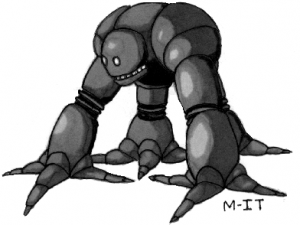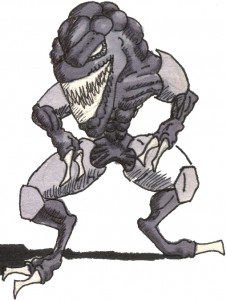 Ahzchim (Tribe)
Ahzchim (Tribe)
This game described is an adaptation of a Scimrahn game that is played with small uniform chips of CCC that are cast offs of industrial processes. The rules below are for converting those rules to a standard deck of 52 cards.
Ahzchim is a card game for 2-10 players. It is a strategy game with the objective of obtaining all the Zahahnie in the deck. At the beginning of the game each player is dealt five cards. The remaining cards are left in the middle of the table in the Pord deck. Play goes clockwise around the table. Each player gets one “turn” every round. One turn is the action of Buying, Attacking, Building a Roke Zibahl or Trading. One “round” the time it takes for everyone to take a turn. The four suits (Hearts, Diamonds, Spades, and Clubs) each serve a different purpose. Play involves the acquisition of cards, building up defenses, attacking and defending Zahahnie. The four suits and the cards in them are explained below.
Hearts = Zahahnie (Food)
The Hearts are Zahahnie, the most important card in the game. The player who obtains all the Zahahnie wins. As soon as a Zahahnie is obtained it is placed on the table face up in front of the player, this is done immediately and automatically and does not take a turn. There are three types of Zahahnie, small, medium, and large. A small Zahahnie is worth one. The two of Hearts through the nine of Hearts are small Zahahnie. The ten of Hearts through the queen of Hearts are medium Zahahnie, and is worth two. The king of Hearts and the ace of Hearts are large Zahahnie, and is worth three. As long as a player has one Zahahnie he or she may draw a card at the end of their turn from the Pord deck. If a player has nine Zahahnie, they may draw two cards at the end of their turn. And if the player has twelve Zahahnie, they may draw three cards at the end of their turn. Players do not have to take their cards if they do not wish to.
Diamonds = Pelmeahe (Labor)
The Diamonds are Pelmeahe, these will be especially important in the beginning of the game. The two through the nine of Diamonds will allow the player to “buy” one card from the Pord deck. The Ten trough the Queen of Diamonds allows the player to buy two cards from the deck. The King and the Ace of Diamonds allow the player to buy three cards from the Pord deck. Buying takes a turn, if a player buys he or she then may draw cards according to their Zahahnie, and play continues on to the next player. The Diamond card used goes face up in the discard.
Secondly the Diamonds can be used to Raze an opponent’s Zahahnie if it does not have a Roke Zibahl (Safehouse).
When a player Razes another player’s Zahahnie they place the Diamond on top of the Zahahnie they want to destroy. If the Zahahnie has a Roke Zibahl on it (see Clubs = Roke Zibahl) it cannot be Razed. The Zahahnie may be defended by placing an “Rahziembiz” (see Spades = Rahziembiz) with a value higher than the attacker’s Pelmeahe card, or the Zahahnie can be “Rebuilt” by placing a Pelmeahe card with a higher value than the attacker’s Pelmeahe card. If the ransackers cannot be defeated, the Zahahnie is placed in the Pord Deck. Any Rahziembiz and Pelmeahe go in the discard pile face up. If the Zahahnie is defended or rebuilt, the defender keeps the Zahahnie. If the Zahahnie is destroyed, then the Pelmeahe and the Zahahnie go in the discard pile face up.
Spades = Rahziembiz (Fighters)
The Spades are the Rahziembiz that a player has. A Rahziembiz is used in attacking or defending Zahahnie. The numerical or face value of the cards go in the order of two though ten, Jack, Queen, King, Ace. Ace being the highest and two the lowest in regards to Rahziembiz. The two of Spades however is the Gieth Bek (Spy) card, it cannot defeat any Rahziembiz but can destroy any Roke Zibahl (Safehouse) reguardless of it’s face value. Roke Zibahls are explained next (see Clubs = Roke Zibahls).
When a player attacks another player’s Zahahnie they place the Spade on top of the Zahahnie they want to take. If the Zahahnie has a Roke Zibahl on it (see Clubs = Roke Zibahls) The value of the Roke Zibahl must be lower than the attacking card or the attack automatically fails, except when using the Spy card (aka.. two of Spades). If the attacking Rahziembiz overcomes the Roke Zibahl, the Zahahnie may be defended by placing a larger Rahziembiz on the attacking Rahziembiz. If the attacking Rahziembiz cannot be defeated, the attacker wins the Zahahnie and places it in front of him or her. Any Rahziembiz and Roke Zibahls go in the discard pile face up. If the Zahahnie is defended either by the Roke Zibahl or defending Rahziembiz, the defender keeps the Zahahnie. If the Roke Zibahl is not defeated the attacking Rahziembiz goes in the discard pile. If the Roke Zibahl is defeated, but the attacking Rahziembiz is defeated both Rahziembiz and the Roke Zibahl are placed in the discard pile face up.
Attacking takes a turn, if a player attacks he or she then may draw cards according to their Zahahnie, and play continues on to the next player.
Clubs = Roke Zibahl (Safehouse)
The Clubs are defending Roke Zibahl or fortifications. They are used in the defending of Zahahnie from attacking Rahziembiz. Only one Roke Zibahl may be built on a Zahahnie. To do this the player places the Roke Zibahl face up on his or her Zahahnie. After this is done, any Rahziembiz of equal or lesser face value is automatically defeated if that Zahahnie is attacked. The exception to this is the Spy card or two of Spades which will defeat any Roke Zibahl. The Two of Clubs is a Reshpel (helper) card, it is the only card that can add on a Roke Zibahl. The Roke Zibahl with a two of clubs on it is considered to be two points higher, thus a three becomes a five, a nine a Jack, a Queen an Ace. This is the only card that can do this.
After a Roke Zibahl is built on a Zahahnie, it cannot be moved. It can however be exchanged for a higher or lower Roke Zibahl that is in the players hand.
Building a Roke Zibahl takes a turn, if a player builds a Roke Zibahl he or she then may draw cards according to their Zahahnie, and play continues on to the next player.
The Pord Deck
The Pord Deck is where all cards come from and where players buy cards. Depending on the number of players, there may be anywhere from forty two (42) to two (2) cards in the Pord deck at the beginning of the game. In any event, sooner or later, the deck will be exhausted. When this happens no more cards are taken from Zahahnie and players cannot buy until the next round. The player who took the last card must wait until his or her next turn. When that turn is over, then he or she shuffles the discard pile and places it face down on the table. This becomes the Pord deck and play continues normally, until the deck is again exhausted. Then the process of waiting a round and reshuffling is repeated until someone wins.
Shaho (Trading)
Players may trade cards on their turn with other players, this can be done in any way as long as both parties agree to the trade. Any card may be traded for any card but only one pair of cards may be exchanged.
Players Without Zahahnie
Players without Zahahnie do not draw from the deck at the end of their turn, and so must use Diamonds to buy cards. Without Zahahnie the player will soon run out of cards. When this happens, the player is out of play.
For a more authentic Scimrahn experience, the game of Ahzcim may be simulated by using poker chips instead of CCC. You will need four different color permanent markers (black red blue and green to be most authentic) or different color chips.
You will need a bowl for each player, plus one and a bag, box or pitcher that will act as the Pord. Chips that have been played go in a bowl in the middle of the table. Each player used their bowl to hide their unplayed chips.
Zahahnie use green ink. There are twenty Zahahnie chips. All but three chips Are marked with the Pah (equivalent of 1) symbol. Two are marked with the Toc (2) symbol. One is marked with a Che (3) symbol.
Pelmeahe use blue ink. There are twenty Pelmeahe chips. All but three are marked with the Pah symbol. Two are marked with the Toc symbol, one is marked with Che.
Rahziembiz use red ink. There are twenty one Rahziembiz chips. Twenty are numbered with the symbols Pah through Koh Koh (or the equivalent of 1-20). One has Gieth Bek written in Scimrahn letters.
Roke Zibahl use black ink. There are twenty one Roke Zibahl chips. Twenty are numbered with the symbols Pah through Koh Koh. One has Reshpel written on it.
There are many variations on Ahzchim that are local or regional using more or fewer tiles and there is evidence that the game is actually Kelrath in origin using very different names for each type of piece, and possibly four times the chips but play is similar.




 The Free RPG Blog
The Free RPG Blog